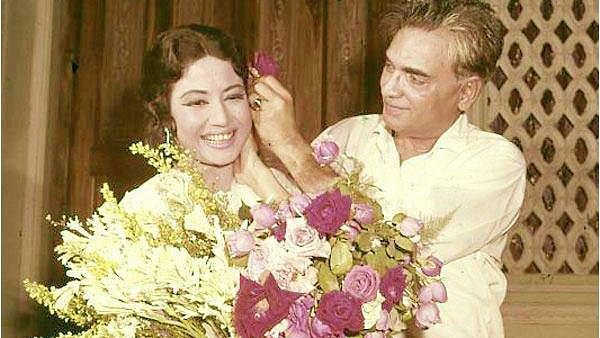Writer-director Kamal Amrohi is best known for Pakeezah, the musical classic starring his wife Meena Kumari, and the Ashok Kumar-Madhubala starrer Mahal.
New Delhi: The fame and appreciation Kamal Amrohi receives goes far beyond his limited body of work. In 34 years, the writer-filmmaker only directed four films, but three of them were the Ashok Kumar-Madhubala starrer Mahal, the Dharmendra-Hema Malini starrer Razia Sultan, and the film that made the dying Meena Kumari immortal, Pakeezah.
Amrohi’s cinema was commercially successful and elegant, showcasing his great eye for detail. His movies told stories of lovers who were unable to cross the boundaries of social conventions (Pakeezah), tradition or marriage (Daera).
On his 101st birth anniversary, ThePrint pays tribute by looking back at his life and work.
Beginnings
Born on 17 January 1918 in Amroha, United Provinces (now Uttar Pradesh), Syed Amir Haider Kamal Naqvi started writing Urdu stories at a very young age. He wanted to write for the silver screen but was discouraged by his father, so he ran away to Lahore at the age of 16. In Lahore, he earned a living by writing stories for a local Urdu magazine, and simultaneously, graduated in Persian and Urdu from the Oriental College.
It was there that Amrohi met K.L. Saigal, who recognised his writing talent and brought him to Bombay (now Mumbai) to write for Sohrab Modi’s Minerva Movietone film company. There, Amrohi worked on movies like Jailor (1938), Pukar (1939), Bharosa (1940) as well as A.R. Kardar’s Shahjehan (1946).
Also read: Remembering Bimal Roy, the filmmaker who brought realism to Hindi cinema for good
Directorial debut
Amrohi made his directorial debut in 1949 with Mahal, a reincarnation movie that set the film world alight. He was just 30 years old when he pitched the idea to Ashok Kumar, who was running Bombay Talkies then.
Amrohi received acclaim for his deft use of chiaroscuro (the treatment of light and shade) as well as its music, including ‘Aayega aanewala’, one of Lata Mangeshkar’s first big hits in Hindi.
Then, in 1953, Amrohi directed Daera, the story of a 16-year-old girl who was forced to marry a man much older than her, but fell in love with a younger neighbour boy. Called “far ahead of its time”, Daera bombed at the box office, but it was important for another reason — it was the first collaboration between Amrohi and his third wife Mahjabeen Bano, whom the world remembers as Meena Kumari.
The Meena Kumari years
Amrohi’s marriage to Meena Kumari is perhaps the most controversial part of his life. They met on the sets of a film — she was 19, he was 34 and twice married. But they married soon afterwards and went on to produce Daera.
Pakeezah followed Daera onto the floors in 1956. Amrohi had poured his heart, soul and personal fortune into the film, but it saw many ups and downs before finally being released in 1972.
The film was initially shot in black and white, then re-shot in colour, and then again in CinemaScope. But it was also shelved for over six years because of a falling out between Meena Kumari and Amrohi. The couple separated but never divorced.
Meena Kumari walked out of Amrohi’s house, never to return, amid allegations of mistreatment. Responding to these allegations, Amrohi admitted he was harsh to her sometimes while advising her on assignments, but “it was all in her interest”.
Amrohi’s daughter Rukhsaar in an interview said that her father didn’t want Meena Kumari to be “in other men’s company”, which is what led to clashes between the couple.
Eventually, when Pakeezah did release, it received a lukewarm response from the critics. Meena Kumari died within weeks of its release, but her death boosted the audience response to the film, and even today, it is considered one of the finest works that she or Amrohi were part of.
The music by Ghulam Mohammed, of course, is one of the most legendary soundtracks in Indian film history — songs like ‘Chalte chalte’, ‘Thade rahiyo’ and ‘Inhi logon ne’ that remain on people’s lips even 47 years later.
In the intervening period, Amrohi continued to write for a handful of films. He was among the four dialogue writers for K. Asif’s magnum opus Mughal-e-Azam, and won the 1961 Filmfare Award for it.
He also founded Kamal Amrohi Studios/Kamalistan, which still stand in Mumbai.
Amrohi died on 11 February 1993, ten years after his last directorial venture Razia Sultan. He was buried next to Meena Kumari at the Rehmatabad graveyard in Mumbai.
Also read: Rajesh Khanna, Bollywood’s first superstar who charmed an entire generation




Very flimsy article, written with little research. There are zero insights into what made him so successful. For example, when Mahal was being cast the studio wanted the leading lady of those days, Suraiya to be the heroine. But Amrohi was firm that for this suspense-filled character, a new actress would be most credile. That’s how Madhubala got cast and evebtually became a superstar.